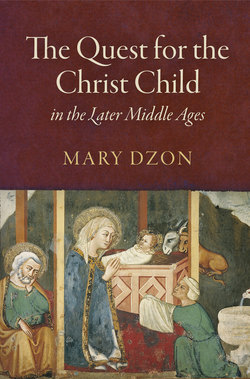The Quest for the Christ Child in the Later Middle Ages

Реклама. ООО «ЛитРес», ИНН: 7719571260.
Оглавление
Mary Dzon. The Quest for the Christ Child in the Later Middle Ages
Отрывок из книги
The Quest for the Christ Child in the Later Middle Ages
Ruth Mazo Karras, Series Editor
.....
The Appeal of Jesus—a Real Child Who Is Nonetheless Divine
Nostalgia of an escapist sort, rather than a healthy desire for personal reformation, may sometimes have instilled the urge to find a lost childhood. More specifically, medieval Christians may have chosen to reflect upon Jesus’ childhood in order to ignore, at least temporarily, the negative aspects of their own lives or to avoid thinking about the suffering Jesus endured as an adult. In the Life of Blessed Margaret of Faenza (d. 1330), a Vallombrosan nun, we learn that she spent a good deal of time, “perfecting her meditations on the childhood of the Savior.” She experienced such “marvelously sweet things (mirabiles dulcedines) during them” that “she did not care to pass onto Christ’s later life (ad altiora conscendere, literally, “to climb to higher things”).”96 Perhaps feeling somewhat offended by the way she ignored his adulthood, Jesus finally told her that it was “not right to wish to taste only the honey and not the gall (de melle meo … & non de felle).” Margaret henceforth concentrated completely on the Passion, with great intensity, apparently exchanging all the honey for gall (though Christ’s rhyming of words suggests that sweetness and bitterness may go hand in hand). Other evidence suggests that at least some medieval people perceived a danger in fascination with Christ’s childhood. Once Humiliana de’ Cerchi (d. 1246), a Franciscan tertiary, was subjected to an illusion by the devil, who, “understanding her desires, showed her the figure of Our Lady and the child Jesus, radiant of face and raiment,” yet the pious widow saw through this demonic trick, which interestingly reveals the imaginative seductiveness, for some, of the Mother-and-Child duo.97
.....